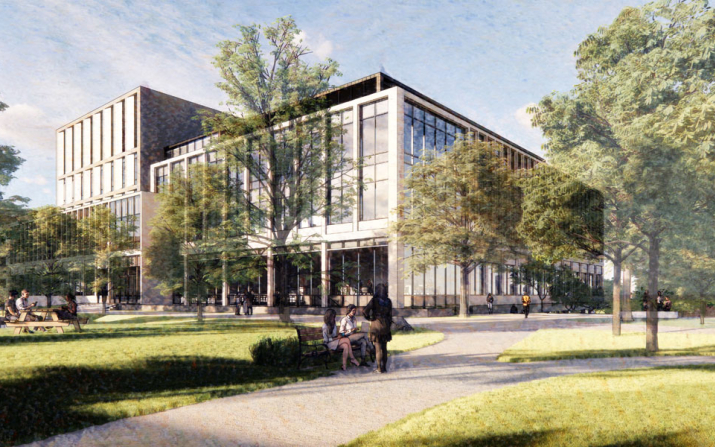President Kaler shares details of historic investment in new research building

President Eric W. Kaler today announced details of Case Western Reserve’s historic new investment in research: a roughly 200,000 square-foot, state-of-the-art structure dedicated to collaborative discovery and innovation.
Estimated to cost $300 million, the Interdisciplinary Science and Engineering Building (ISEB) represents the university’s largest-ever Case Quad project. More, it is the first to offer a welcoming façade to those passing on Martin Luther King Jr. Blvd.
“Research and community engagement are two of the university’s highest priorities,” President Kaler said. “This initiative represents an unprecedented step forward in both areas. It will be transformative.”
The collaborations taking place in the new building will aim to address some of the globe’s most urgent issues. Examples include climate change, applications of artificial intelligence and multiple aspects of improving health outcomes—among them, reducing health disparities.
“We want to solve problems,” Kaler said, and “bring discoveries to people to make their lives better.”
As part of achieving these goals, the ISEB departs from earlier higher education practices of organizing infrastructure by departments. Instead, this structure will offer spaces for researchers with complementary expertise to work together to solve such complex challenges.
“The world’s problems today demand more interdisciplinary expertise than ever before,” said College of Arts and Sciences Dean Joy K. Ward.
Added Case School of Engineering Dean Ragu Balakrishnan, “that’s how you make impact.”
While the building’s labs and related spaces will focus on needs for research in science and engineering, both deans emphasized the value of collaborations that extend beyond those areas. Recent joint efforts between university physics and art history scholars to apply artificial intelligence to identify artists’ works through their brushstrokes, for example, have drawn international attention. The work of engineering professor Dustin Tyler’s Human Fusions Institute, meanwhile, engages profound questions involving psychology, philosophy and more.
Campus officials emphasized that planning is too preliminary for any individuals or particular specializations to be assigned to the space. Instead, they are continuing conversations with faculty to hear insights about opportunities and challenges and identify emerging themes.
Case Western Reserve has retained HGA, a national architecture firm with extensive experience in higher education, after a competitive evaluation process last year. Campus leaders charged the firm with designing a structure that appears welcoming from the outside, and continuing to convey that inviting spirit once people enter it. The first floor includes an open area described as an ‘academic living room’; its goal is to provide a place for people to gather for casual conversations and research-focused ones.
Equally important is a design that continually encourages people to engage with one another.
“We want to create an environment where all of these [research] groups are finding a place of interaction,” said Peter Cook, a design principal at HGA and lead architect on the project.
“There will be serendipitous collisions,” Balakrishnan said, citing spontaneous conversations that can lead to collaborative projects. The building “will be a catalyst.”
The need for additional and more modern research space in science and engineering has existed for many years. In 2015, the university’s master plan emphasized the importance of upgrading existing facilities, specifically recommending new shared research space for science and engineering. At that time, the average age of university research buildings was 56 years old.
Appointed last year after a national search, Senior Vice President for Research and Technology Management Michael Oakes is leading the ISEB project. It is essential for many reasons, Oakes says, including the ability to keep leading faculty and attract outstanding researchers to campus.
“We need to do this,” he said. “It’s needed for us to grow and still compete.”
Oakes also emphasized the economic benefits that research—and, in turn, commercialization of meaningful discoveries—can have for greater Cleveland.
To make space for the new structure, this summer crews will demolish Yost Hall, a 1951 building that previously served as student housing, and now includes office space. The ISEB is scheduled for completion by 2026, the bicentennial of the university’s founding.
Half of the project’s overall expense is being covered by $150 million from century bonds the university issued last year, with the remainder to be funded through philanthropy.
